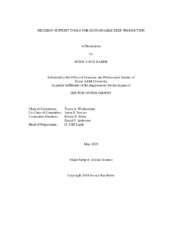| dc.description.abstract | Net protein contribution (NPC), enteric methane emissions and profitability were modelled to evaluate the sustainability of beef production under various management strategies. In experiment 1, methodology, production characteristics, and diet characteristics of the 3 sectors of the beef value chain were established. In experiment 2, evaluated the effects of increasing length of confinement for the cow-calf sector (0, 4, 8, or 12 months of confinement) on NPC, enteric methane, and profitability. Experiment 3 analyzed trends in NPC from 2006 to 2017 using 8 commercial feedlots in Texas and Kansas and categorized feedlots into improving NPC (INC) or constant NPC (CON). Ratio of protein quality (PQR) of diets fed and beef produced were calculated using digestible indispensable amino acid scores (DIAAS). Additionally, human-edible protein conversion efficiency (HePCE) was calculated. Net protein contribution was calculated by multiplying PQR and HePCE. Beef value chains and all sectors within are contributing positively to human protein requirements as indicated by a NPC above 1. Net protein contribution was reduced when length of intensification of cow-calf sector increased, however enteric methane production was reduced as length of intensification increased. Feedlots have improved net protein contribution over time. Feedlots categorized as INC have improved NPC from 2006 to 2017 (P = 0.02). Greater cereal grain inclusion and lower byproduct inclusion was observed for INC compared to CON (P < 0.01). Experiment 4 was conducted to compare nutrient utilization and energy balance of limit-fed diets consumed by pregnant heifers. Heifers were randomly assigned to 1 of 2 treatments, a forage diet (FOR; 2.10 Mcal ME/kg) or a concentrate diet (CONC; 2.94 Mcal ME/kg), and individually fed to meet maintenance energy requirements (0.135 Mcal ME/kg BW^0.75). Dry matter and organic matter digestion was greater for CONC than FOR (P < 0.01). Energy lost as methane (% of GE intake) was not different between treatments (P = 0.49). The ratio of ME to DE was greater for CONC (86.8 vs 82.8; P = 0.01). The ratio of ME to DE may be dependent on diet and level of intake and is more dynamic than current feeding systems describe. | en |


